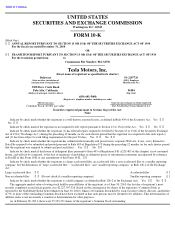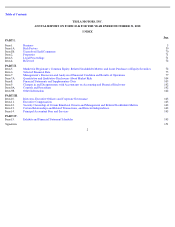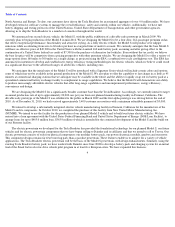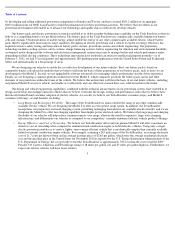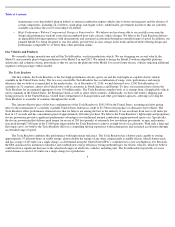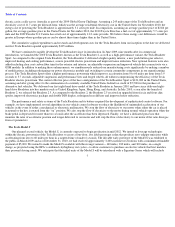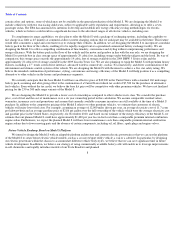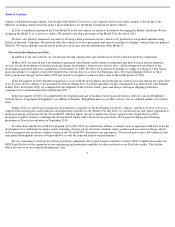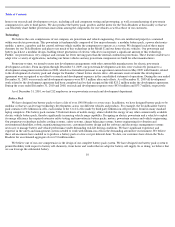Tesla 2011 Annual Report Download - page 9
Download and view the complete annual report
Please find page 9 of the 2011 Tesla annual report below. You can navigate through the pages in the report by either clicking on the pages listed below, or by using the keyword search tool below to find specific information within the annual report.
Table of Contents
certain colors and options, some of which may not be available in the general production of the Model S. We are designing the Model S to
include a third row with two rear-facing child seats, subject to applicable safety regulations and requirements, allowing us to offer a seven
passenger sedan. The EPA has announced its intention to develop and establish new energy efficiency testing methodologies for electric
vehicles, which we believe could result in a significant decrease to the advertised ranges of all electric vehicles, including ours.
To complement its range capabilities, we also plan to offer the Model S with a package of recharging options, including the capability to
fast charge in as little as 45 minutes at commercial direct current charging stations that we anticipate may be available in the future. This feature
would offer consumers a rapid and convenient way to recharge their vehicles. In addition, we are designing the Model S to incorporate a modular
battery pack in the floor of the vehicle, enabling it to be rapidly swapped out at a specialized commercial battery exchange facility. We are
designing the Model S to offer a compelling combination of functionality, convenience and styling without compromising performance and
energy efficiency. With the battery pack in the floor of the vehicle and the motor and gearbox in line with the rear axle, we are designing the
Model S to provide best in class storage space of approximately 29 cubic feet, including storage under both the tailgate and the hood. By way of
comparison, this storage space exceeds the approximately 14 cubic feet of storage available in the 2009 BMW 5 Series sedan and the
approximately 21 cubic feet of storage available in the 2009 Lincoln Town Car. We are also planning to equip the Model S with premium luxury
features, including a 17” touch screen driver interface, advanced wireless connectivity, such as 3G connectivity, and driver customization of the
infotainment and climate control systems of the vehicle. We are designing the Model S with the intent to achieve a five star safety rating. We
believe the intended combination of performance, styling, convenience and energy efficiency of the Model S will help position it as a compelling
alternative to other vehicles in the luxury and performance segments.
We currently anticipate that the base Model S will have an effective price of $49,900 in the United States with a standard 160 mile range
battery pack, assuming and after giving effect to the continuation of a United States federal tax credit of $7,500 for the purchase of alternative
fuel vehicles. Even without the tax credit, we believe the base list price will be competitive with other premium vehicles. We have not finalized
pricing for the 230 or 300 mile range variants of the Model S.
We are designing the Model S to provide a lower cost of ownership as compared to other vehicles in its class. We consider the purchase
price, cost of fuel and the cost of maintenance over a six year ownership period in this calculation. We assume comparable residual values,
warranties, insurance costs and promotions and assume that currently available consumer incentives are still available at the time of a Model S
purchase. In addition to the competitive pricing of the Model S relative to other premium vehicles, we estimate that customers of electric
vehicles will enjoy lower fuel costs. For example, assuming an average of 12,000 miles driven per year, an average electricity cost of 11.7 cents
per kilowatt-
hour and an average gasoline price of $2.86 per gallon over the full ownership of the vehicle which were the average electricity cost
and gasoline price in the United States, respectively, for November 2010, and based on our estimate of the energy efficiency of the Model S, we
estimate that our planned Model S could have approximately $1,400 per year less in fuel costs than a comparable premium internal combustion
engine sedan. Furthermore, we expect the planned Model S will have lower maintenance costs than comparable premium internal combustion
engine sedans due to fewer moving parts and the absence of certain components, including oil, oil filters, spark plugs and engine valves.
Future Vehicle Roadmap Based on Model S Platform
We intend to design the Model S with an adaptable platform architecture and common electric powertrain so that we can use the platform
of the Model S to create future electric vehicle models, such as a crossover/sport utility vehicle, a van or a cabriolet. In particular, by designing
our electric powertrain within the chassis to accommodate different vehicle body styles, we believe that we can save significant time in future
vehicle development. In addition, we believe our strategy of using commercially available battery cells will enable us to leverage improvements
in cell chemistries and rapidly introduce models of our Tesla Roadster and planned
8


